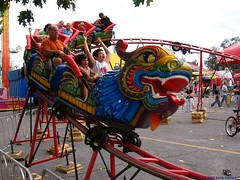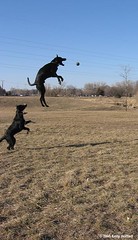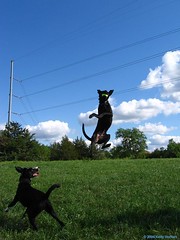Assignment 5: Action!
Previous Assignment: Patterns and Textures
Out of all the different kinds of photography you can do, the one that involves the most trial-and-error is action photography. But when you do get a great action shot, it's just that much more impressive. So this week, I want you to go out and capture some action shots. Don't be surprised if they don't turn out all that well. As I've said before, 25% of photography is luck, but you also need to remember that 25% of it is dedication, and the two of those are going to be your best friends when you try to get action shots.
Tips:
- Try to figure out where the action is going to happen in advance. If you can, focus and get an exposure reading before the action gets there.
- If you're using auto-focus, pressing the shutter down halfway will cause the camera to focus and get an exposure reading so that when the action gets there, you can snap it a bit faster.
 - Your camera may have a burst mode. The icon for it will probably look something like this, an image of three frames stacked on top of one another. A new high-end Canon camera will be able to shoot 3 frames per second for up to 9 seconds at very high quality, but unless you've spent quite a bit of money on your camera I doubt it will do that. If you have trouble locating this feature, you may not have it, but consult your manual. On my camera at least, it's in the same menu as the time-delay functions.
- Your camera may have a burst mode. The icon for it will probably look something like this, an image of three frames stacked on top of one another. A new high-end Canon camera will be able to shoot 3 frames per second for up to 9 seconds at very high quality, but unless you've spent quite a bit of money on your camera I doubt it will do that. If you have trouble locating this feature, you may not have it, but consult your manual. On my camera at least, it's in the same menu as the time-delay functions.One of the problems with shooting in burst mode is that it will keep a constant exposure reading and focus throughout the shooting, so if the action gets closer to you it may become dark or out of focus. See this picture for an example:
(Click to see it larger, opens in new window)
This is four consecutive shots taken with burst mode. Note how they get darker as the rollercoaster blocks the light. Also, when you shoot with burst mode, you won't be able to use flash, because the flash needs time to recharge after each shot. If burst isn't working for whatever reason, you'll just have to work on your timing. In the end, I turned on my flash for some fill and got the timing right for this shot:

Composition can be very difficult with these kinds of shots because there's so much going on and it's hard to get in position to do the right thing. But the more you try, the more likely you are to get at least one good shot. Compare these two shots of my dog Russell taken months apart in terms of composition:


By looking at these, you can see that catching the perfect moment isn't everything. In both of them he's at a very high point in his jump. But in the first one, although Lily gives you a sense of how high he's jumping and draws attention in to him (because she's looking at him), her tail is cut off, and that hurts the composition. Also, the colors are kind of drab. In the second one, on the other hand, she's completely in the frame and she draws attention to him just as well as in the first one. Still, I wish those power lines weren't there. There's an example of a shot I've tried over and over to get right, and still haven't done it, so I'll keep at it!
I still haven't captured that perfect action shot, so I wouldn't be surprised if any of my readers beat me to the punch on that one.
So, try your hand at some action photography, and then you can share them with the group!
Next Assignment: Less Is More

0 Comments:
Post a Comment
<< Home